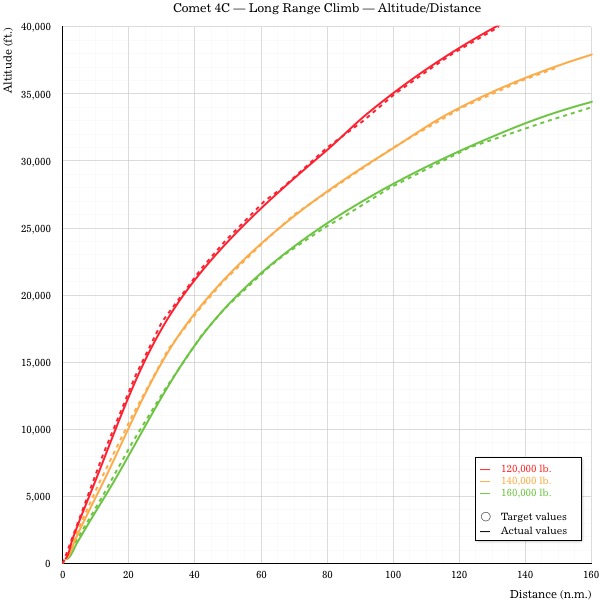Comet 4c - Climb Performance
01/08/16 23:30
The following graphs show the latest climb performance in X-Plane 10.45. The real Comet 4C is shown as a dotted line, and the model is a solid line. Three weights were sampled, shown in different colours on the graphs.
Tests were run using the flight-test program developed for the Comet earlier this year. The program is fully automatic. It carries out climbs, to procedure, varies the coefficient of drag of the nacelle bodies to control the rate of climb, and records the results to a text file at 100 feet intervals. This is used as the basis of a drag correction function in a Comet plug-in called "Dynamics". The graphs show the performance with that plug-in running.

The high speed climb procedure was in three phases:
The real Comet was equipped with the second-generation Smiths Electronic Pilot (or "SEP-2"), which could handle phase 2, but not phase 1 or 3. Phase 1 would have been flown manually; for phase 3, pilots could have used the SEP in fixed pitch mode, keeping a watchful eye on the Mach meter.
The SEP-2 was a sophisticated piece of kit in 1958, but it lacked features that became common place 10 years later. I'm not intending to provide a cheat for this, so people appreciate the extra work by pilots during that era. Obviously, anyone with a good working knowledge of X-Plane, keystroke short cuts, or Dataref Editor, could easily cheat if they want to.

The long range climb was in the same three phases, and same engine revs, but different speed and altitude thresholds:
"High speed climb" did not refer to rate of climb. Actually, the long range climb achieved the required altitude sooner, and in a shorter horizontal distance, with a 25% saving in fuel. The high speed climb's shallower gradient and faster ground speed was a way of covering more horizontal distance in the shortest possible time (while guzzling fuel).
Next step: cruise tests.
--
GMM-P
(01-08-2016)
Tests were run using the flight-test program developed for the Comet earlier this year. The program is fully automatic. It carries out climbs, to procedure, varies the coefficient of drag of the nacelle bodies to control the rate of climb, and records the results to a text file at 100 feet intervals. This is used as the basis of a drag correction function in a Comet plug-in called "Dynamics". The graphs show the performance with that plug-in running.

The high speed climb procedure was in three phases:
- Climb and accelerate to an indicated airspeed of 295 knots at 8,000 feet.
- Climb at fixed IAS of 295 knots until 0.79M (which happens at about 31,000 feet).
- Climb at 0.79M to the required cruise altitude.
The real Comet was equipped with the second-generation Smiths Electronic Pilot (or "SEP-2"), which could handle phase 2, but not phase 1 or 3. Phase 1 would have been flown manually; for phase 3, pilots could have used the SEP in fixed pitch mode, keeping a watchful eye on the Mach meter.
The SEP-2 was a sophisticated piece of kit in 1958, but it lacked features that became common place 10 years later. I'm not intending to provide a cheat for this, so people appreciate the extra work by pilots during that era. Obviously, anyone with a good working knowledge of X-Plane, keystroke short cuts, or Dataref Editor, could easily cheat if they want to.

The long range climb was in the same three phases, and same engine revs, but different speed and altitude thresholds:
- Climb and accelerate to an indicated airspeed of 265 knots at 7,000 feet.
- Climb at fixed IAS of 265 knots until 0.71M (which happens at about 30,000 feet).
- Climb at 0.71M to the required cruise altitude.
"High speed climb" did not refer to rate of climb. Actually, the long range climb achieved the required altitude sooner, and in a shorter horizontal distance, with a 25% saving in fuel. The high speed climb's shallower gradient and faster ground speed was a way of covering more horizontal distance in the shortest possible time (while guzzling fuel).
Next step: cruise tests.
--
GMM-P
(01-08-2016)
blog comments powered by Disqus
